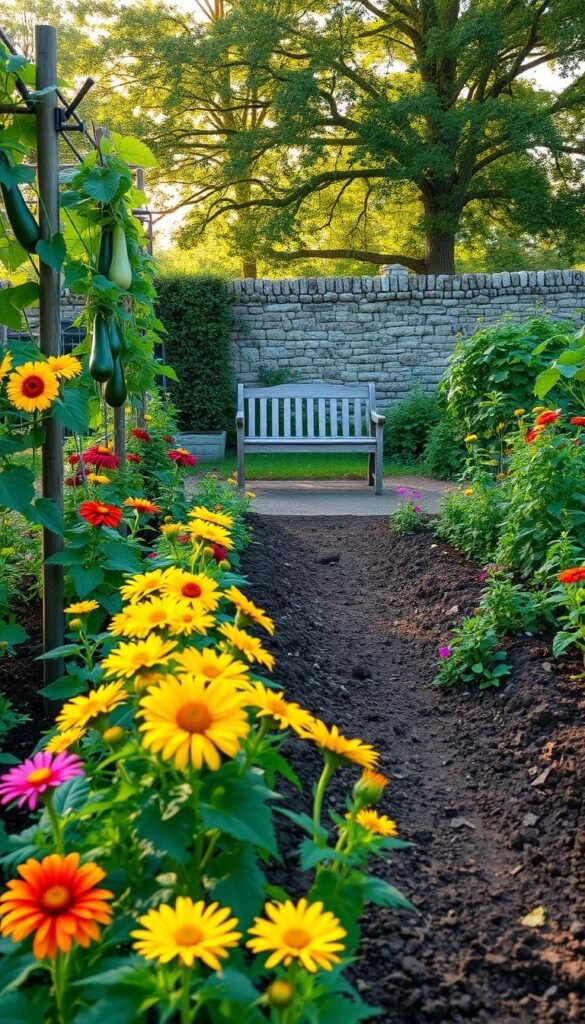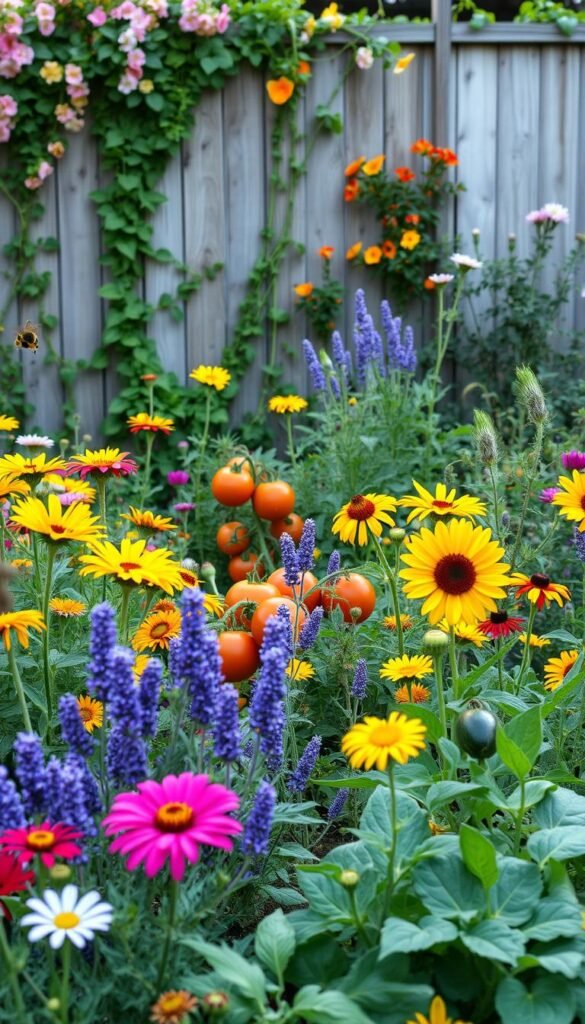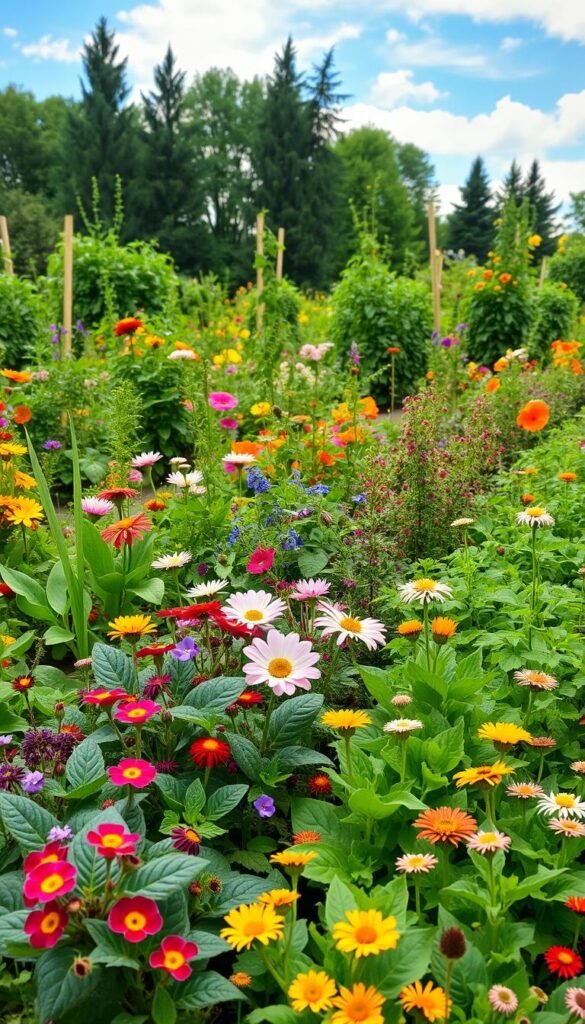Imagine stepping into a vibrant space where beauty meets practicality. By blending colorful blooms with edible crops, you create a living tapestry that nourishes both people and nature. This approach transforms ordinary plots into dynamic ecosystems buzzing with life.
Strategic pairings like blueberry bushes with fragrant herbs or tomatoes alongside bright blossoms do more than look pretty. These combinations boost pollination rates while naturally deterring pests. Your space becomes a self-sustaining habitat where every plant serves multiple purposes.
Small spaces thrive with this method too. Even patio containers can host chili peppers next to cheerful annuals. You’ll enjoy fresh produce alongside continuous bursts of color through seasons. The result? A landscape that’s as productive as it is eye-catching.
Through smart design choices, your growing area works harder. Beneficial insects find shelter, soil health improves, and harvests increase. Best of all, this system adapts effortlessly—whether you’re tending acres or window boxes.
Getting Started with Your Mixed Garden – Benefits and Basic Preparation

Transform your outdoor space into a thriving ecosystem by matching plants to your unique growing conditions. Smart planning lets you double your harvests while creating habitats for helpful insects.
Assessing Your Garden’s Conditions and Space
Track sunlight patterns for 3 days using a simple sketch. Note which areas get full sun (6+ hours) versus partial shade. Check drainage by digging a 12″ hole and timing how fast water disappears.
“Layered root systems let plants share resources without fighting for space – nature’s perfect teamwork.”
Use this table to pair plants based on root depth:
| Root Depth | Edible Plants | Blooms/Herbs |
|---|---|---|
| Shallow | Lettuce, Spinach | Marigolds, Pansies |
| Medium | Carrots, Beans | Zinnias, Basil |
| Deep | Tomatoes, Asparagus | Lavender, Echinacea |
Choosing the Right Flowers and Vegetables for Your Locale
Match plants to your USDA zone and local rainfall patterns. Nurseries often label regional superstars – look for tags saying “native” or “drought-tolerant”. For best companion plant pairings, combine quick-growing radishes with slow-developing peppers.
Test your soil’s pH using a $7 kit from garden centers. Most edibles prefer 6.0-7.0, while flowers like hydrangeas can handle more acidity. Amend with compost based on test results – your plants will thank you!
Flower and Vegetable Garden Combined: Attract Pollinators and Grow Food

Unlock your plot’s full potential by crafting layouts that serve pollinators and your harvest goals. Thoughtful arrangements turn ordinary beds into buzzing hubs where beauty and productivity coexist seamlessly.
Strategic Planting for Pollinator Traffic
Group nectar-rich blooms in clusters of 3-5 plants. Bees spot these floral buffets faster than single specimens. Try mixing cosmos with zinnias—their flat blooms welcome butterflies, while tubular salvias entice hummingbirds.
Incorporate night-blooming varieties like moonflowers near tomatoes. Moths handle late shifts, pollinating crops after sunset. Use this table to match flower shapes with visitors:
| Bloom Type | Best For | Plant Examples |
|---|---|---|
| Tubular | Hummingbirds | Bee balm, Penstemon |
| Flat | Butterflies | Zinnias, Daisies |
| Bowl-shaped | Bees | Poppies, Sunflowers |
Blending Form and Function
Create winding paths edged with marigolds and basil. You’ll enjoy easy harvest access while guiding beneficial insects toward squash blossoms. Alternate blue borage with golden calendula for color contrast that dazzles human eyes and bee vision alike.
Stagger bloom times by planting early summer phlox beside late-bearing peppers. This ensures constant nectar flow from spring through frost. Your beans get pollinated, and you get nonstop color!
Place lavender near walkways where its scent greets visitors. The purple spikes attract pollinators while repelling deer. Every design choice pulls double duty—beauty that works as hard as you do.
Companion Planting Strategies to Attract Beneficial Insects

Boost your garden’s health by teaming up plants that work together like nature’s own pest control squad. Smart pairings create living partnerships where blooms and edibles support each other’s growth while keeping troublemakers at bay.
Pairing Flowers That Draw Pollinators
Marigolds become superheroes when planted near tomatoes or squash. Their roots release natural chemicals that repel nematodes and beetles. Zinnias act as landing pads for lacewings—their larvae devour aphids while adults pollinate your crops.
Integrating Aromatic Herbs and Native Plants
Let basil and oregano flower near your tomatoes. Their fragrant blooms attract tiny wasps that hunt hornworms. Dill works magic near cabbage patches, luring beneficial insects that snack on leaf-eating caterpillars.
“Native milkweed isn’t just for monarchs—it feeds countless pollinators while strengthening your garden’s natural defenses.”
Leveraging Companion Plants to Naturally Deter Pests
Nasturtiums serve as sacrificial plants, drawing aphids away from your veggies. For companion gardening plant pairings that multitask, try these combinations:
| Protector Plant | Protected Crop | Pests Deterred |
|---|---|---|
| Garlic | Peppers | Spider mites |
| Borage | Strawberries | Japanese beetles |
| Radishes | Cucumbers | Cucumber beetles |
Rotate squash family plants yearly to confuse pests. Leave spent marigold roots in soil—their decaying matter fights harmful nematodes for seasons to come.
Wrapping Up – Your Next Steps for a Vibrant, Productive Garden
Now’s the time to put your plans into action. Start small by pairing marigolds with tomatoes or sunflowers with cucumbers—these proven combinations build confidence while boosting yields. Add shallow dishes with pebbles and fresh water to welcome thirsty bees and butterflies during summer heatwaves.
Leave small brush piles and stone stacks in corners—they become cozy homes for helpful insects. Resist tidying up every fallen leaf; seed heads and leaf litter shelter overwintering pollinators while feeding birds. Did you know 3 out of 4 food crops need these tiny workers? Your space matters more than you think.
Track what thrives in your soil and sunlight. Swap out struggling pairs for better matches next season. Connect with local gardening groups to swap seeds and tips—they’ll help you refine your approach. With each smart choice, you’re growing more than plants—you’re nurturing life itself.






